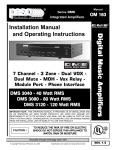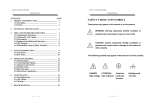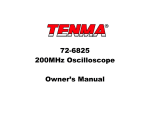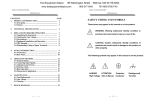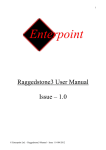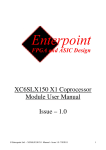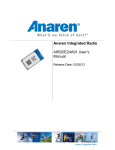Download ATO EQ-Link system Specifications
Transcript
EQ LINK & EQ-Reverse-LINK www.wirelessaviationheadsets.com No part of this manual may be copied, transcribed, translated or reproduced in any manner or form whatsoever, for commercial purposes, without obtaining prior written permission from Lysar Industries. However, limited copying is permitted for private use providing authorship is acknowledged. Caution No internal changes to the equipment may be performed or this could void the user’s authority to operate the equipment. © Copyright of Lysar Industries 2013. Print date: November 2013 Literature Reference: EQ Link & EQ-R-Link Guide EQ Wireless CONTENTS 1. 1.1. 1.2. Introduction...........................................................................................1 About This Manual ...........................................................................1 Glossary of Terms ............................................................................1 2. Functional Overview .............................................................................2 2.1. System Features ..............................................................................3 3. Basic Operation ....................................................................................4 3.1. EQ-Link Controls ..............................................................................4 4. 4.1. 4.2. 4.3. 4.4. 4.5. System functions ..................................................................................5 EQ-Link ............................................................................................5 EQ-Link Pairing ................................................................................5 PTT Detection ..................................................................................6 MP3 or Cell Phone Interface ............................................................6 EQ-Link Communications Settings ..................................................7 5.1. Installation ............................................................................................9 Installation EQ-Link system..............................................................9 5. 6. EQ-Link / EQ-Reverse-LINK charging................................................10 7. Hints and Tips on Operation...............................................................11 8. voice menu Programming EQ Reverse-LINK.....................................12 EQ Reverse-LINK ..........................................................................12 Noise Reduction ON/OFF ..............................................................13 Paring Mode ON/OFF ....................................................................13 VOX Menu......................................................................................13 Volume Menu .................................................................................13 Mic Level Menu ..............................................................................13 Mixture Menu .................................................................................13 Factory Restore..............................................................................13 8.1. 8.2. 8.3. 8.4. 8.5. 8.6. 8.7. 8.8. 9. voice MENU programming the EQ-Link .............................................14 Lysar Industries Contents 1 Manual Title 9.1. 9.2. 9.3. 9.4. Microphone Noise Reduction .........................................................15 Echo Reduction ..............................................................................15 Intercom Mode ...............................................................................15 Phone Mode ...................................................................................15 10. Device Specifications .........................................................................16 11. Legal ...................................................................................................17 Contents 2 Lysar Industries Operation Manual 1. INTRODUCTION 1.1. About This Manual The main purpose of this manual is to provide information to ensure the optimum use and performance of the EQ Link and EQ Reverse Link Wireless Communications system. It also provides advanced information for users who require extra functions other than those supplied “out of the box”. 1.2. Glossary of Terms VOX SIDE TONE ANC AEC Hz kHz MHz PSU PTT DSP MNR Lysar Industries Voice Operated Switch This is a mechanism whereby the voice sounds trigger an electronic switch to turn a circuit on, usually it links the microphone to the transmitter or other headsets. This is the small amount of your own voice that you hear in your own ears when talking. Active Noise Cancellation This process used electronic circuits to reduce the sounds that you hear in your own ear from external noise. Active Echo Cancellation Hertz (measure of frequency) Kilohertz (measure of frequency) Megahertz (measure of frequency) Power Supply Unit Press To Talk Digital Signal Processor Microphone Noise Reduction Page 1 Operation Manual 2. FUNCTIONAL OVERVIEW Thank You for purchasing the EQ Link and EQ Reverse Link (EQ-R-Link) system. The EQ Wireless Communications system is a state of the art audio communication device specifically designed for Aviation headset applications in high noise environments. The EQ wireless system is compact; it includes re-chargeable batteries and microphone noise cancelling circuits for optimum listening pleasure. The devices feature only the essential controls to ensure ease of operation. Advanced configuration and operations can be accessed using the simple voice menu controls. The EQ Reverse-Link makes virtually any aviation headset EQ wireless compatible, this enables users to enjoy their own headset with the new wireless experience. The development of the EQ Wireless Communications system represents a significant breakthrough in the field of wireless communications. For the first time, pilots have access to a product, which is affordable, yet offers a very high grade of voice and noise performance and is very simple to use. The technical specification of the EQ-Reverse Link system will enable reliable communications up to distances of 10 meters, depending on conditions. In addition, the EQ transceivers incorporates superior signal handling capability, which ensures excellent reception even in the most crowded radio environments. The EQ LINK-LR (long range) is also available to extend the communications distance if required. In short, this revolutionary new system incorporates the very latest in RF design technology, making the EQ the most compact, versatile, high performance Headset communications solution available in the commercial market today suitable for high noise open and closed cockpit applications. Page 2 Lysar Industries Operation Manual 2.1. System Features The system includes the following functionality: • Full voice prompting system for ease of user interface navigation and control. • Headset Volume and VOX controls to suit the user headset. • Microphone noise cancelling algorithms. • Auto Muting of Auxiliary audio inputs during VHF reception. • Auto VOX open on PTT for no loss of voice conversations. • Wireless PTT control from EQ R-Link to EQ-Link (optional in-line PTT switch required) • Wireless EQ-Link for ease of installation in Aircraft. • Optional MP3/Cell Phone (Bluetooth) Interface. EQ LINK Lysar Industries EQ-R-LINK Page 3 Operation Manual 3. BASIC OPERATION 3.1. EQ-Link Controls The EQ-Link has a number of controls and system inputs, these are described below: Mini USB Used for charging. 3.5mm Audio User for Cell Phone/Blue Tooth or MP3 player. Status Button Used to read battery capacity, transmitted to headset. Used also to change mode from Master to Slave. Used to enter Menu Mode for advanced features. Status LED’s Green is used for charging indication and Master Indication. Yellow is used for PTT indication and Slave Indication. Status LED’s Mini USB Audio Input Status Button Page 4 Lysar Industries Operation Manual 4. SYSTEM FUNCTIONS 4.1. EQ-Link The EQ-Link is the heart of your headset system that wirelessly connects the EQ Reverse-Link and provides the interface for your radio and communications system. The EQ-Link will power on when your aircraft’s communication system operates. Please note Pairing and other setting can be changed by plugging EQ-Link into its supplied charger but the EQ-Link must be plugged in to a powered intercom system in order for communications to operate properly. 4.2. EQ-Link Pairing The EQ-Reverse Link and EQ-Link have been paired at the factory and no other pairing procedure is required. If you wish to pair a new Reverse-Link and EQ-Link please follow the instructions below: To pair a EQ-R-Link to a new EQ-Link: Connect your wired headset to the Reverse Link and Press the button on the Reverse Link module. Power the EQ-Reverse-Link with your headset connected. Set EQ Reverse-Link to pairing mode from Advanced Voice Menu. (section 9.2) Power the EQ-Link by aircraft connection or charging cable. Ensure that the EQ-Link that you wish to pair to is set to Master.(see P13) The EQ Reverse-Link should then detect the EQ-Link and announce the last 4 digits of the serial number of EQ-Link. This serial number can be found on the back to the EQ-Link. If this is the correct unit as indicated in the headset then press the button on the EQ R-Link to confirm and lock to this unit. Your EQ Reverse-Link and headset is then paired to this EQ-Link and will only link to this unit. Lysar Industries Page 5 Operation Manual 4.3. PTT Detection The EQ-Link can detect when the aircraft PTT is activated, this is indicated by the YELLOW LED going fully on. This can aid in the detection of PTT Faults and also as a general PTT indication. On each PTT press a short tone (BEEP) will be heard in the headset and when PTT is released a short tone (BOP) will also be heard. We call these comfort tones and they give feedback that you really have pressed and released the PTT button in the aircraft. Note: This feature is only available when aircraft’s headset jacks are wired for PTT The VHF radio system has override priority and will mute all other ancillary inputs such as MP3, cell phone UHF etc; when a PTT signal is detected on this input. Some aircraft may not have this feature configured on the headset jack and hence this feature will not work. The feature is also extended to the EQ-Reverse-Link so that the yellow LED will also indicate active PTT. The EQ-Reverse-Link can also be used to activate PTT remotely. A standard in-line PTT switch is required. Again this feature must be wired on the aircrafts headset jacks in order to operate properly 4.4. MP3 or Cell Phone Interface The EQ-Link has additional inputs suitable for Cell or MP3 type connections, these are available on the 3.5mm connector at the end of the EQ Link. Note: During VHF reception 3.5mm Audio input is muted to the headsets, this will always enable clear reception of all VHF radio traffic. To stop the phone or cell being muted, turn on “Phone Mode” in the EQ-Link. An EQ approved Blue Tooth Module specially designed to suit the EQ1 System is available for Cell interface. When using this module ensure that the module is mounted at least 400mm away from the EQ Link to avoid RF interference. Usually the Blue Tooth module should be positioned in an accessible area of the aircraft. Page 6 Lysar Industries Operation Manual 4.5. EQ-Link Communications Settings The EQ-Link will function at peak performance when the aircrafts communications settings can be adjusted to suit. The EQ-Link acts as a cable replacement for standard Headsets and as such will receive any imperfections in the aircraft communications system. Advanced features can be activated on the EQ-Link to further assist the noise reduction performance of the system. These modes are activated by 3 fast clicks of the STATUS button on the EQLink. (same technique on EQ-Reverse-Link) These modes will be announced on the paired headset for ease of use and understanding of the functions performed. A single press of the EQ Link Button or EQ-Reverse-Link button will announce the battery capacity of this device into the Headset. The battery capacity will also be announced when the units turn OFF, this gives the user the knowledge of how many more hours the system can be used before re-charge. Lysar Industries Page 7 Operation Manual Standard EQ Link Modes include: Microphone noise cancelling DSP algorithms. This mode will process the audio from the headset microphone and provide additional filtering and processing to reduce noise induced into the headset microphone and can be very useful for noisy aircraft situations. Echo Cancelling The EQ Wireless system provides digital audio communication between the headset and the EQ Link, this technique will introduce delays in the audio system and if further delays are present in the aircraft intercom system then the result to the user can be delayed side tone or echo. If this is not acceptable in your installation then ECHO Cancelling mode can be selected to reduce this effect. When first turned ON the system will adapt and cancel the echo, this can take a few seconds of conversation. Intercom Mode Intercom mode is typically used in systems such as hand held radio’s when no system side tone is present. In this mode the microphone signal from the headset is routed back to the headset from the EQ Link to provide side tone to the headset user. This will also enable multiple headsets to operate on one EQ Link and allow other headsets to hear all conversations of other headsets linked to the Hand Held Radio. Phone Mode EQ Link phone mode will allow the MP3/Cell interface to remain active during all voice activity and this port will NOT be muted during VHF reception. Page 8 Lysar Industries Operation Manual 5. INSTALLATION 5.1. Installation EQ-Link system The EQ-Link system is supplied with a standard aviation cables and connectors (jacks) to suit standard aviation connections. The EQ-Link system will automatically power ON when the aircraft communications system is turned on, and will automatically power off when the communications is switched off. A permanent optional charge cable can be connected for peace of mind to ensure the EQ equipment is always charged. When your aircraft communications is switched off the EQ-Link and EQ Reverse-Link will automatically power OFF after about one minute. Simply connect your EQ-Link into where your normal headset would be connected. The EQ-Link is supplied with Velcro for simple mounting and a cable clip for additional support. For additional performance operation when multiple EQLink units are used on one aircraft simply set extra units to SLAVE mode. In this mode all the units will operate as one and not interfere with each other, there must be at lease one EQ-Link in master mode in all systems. Slave mode can be entered by pressing and holding the STATUS button for 4 seconds, the LED lights will then change every 2 seconds from Master to Slave and announce this in the headset. When on the desired mode, just release the button. Plug your normal headset into the connections on the EQ R-Link, press and hold the ON button for 4 seconds and the EQ R-Link will turn ON. NOTE: A typical aircraft can only have one master and up to 5 slaves in the single system for peak performance, in the case of more units please contact your supplier for additional information on your options. YOUR INSTALLATION IS NOW COMPLETE………… Lysar Industries Page 9 Operation Manual 6. EQ-LINK / EQ-R-LINK CHARGING The EQ Reverse Link systems have the most advanced battery monitoring and charging system of any headset system on the market today. This ensures that your flying will be trouble free and you are able to judge the operational time of your EQ headset system correctly. The devices are fitted with the latest NiMh low loss technology. These batteries will lose approximately 1% of their stored charge per month when not in use. Fully charged, the system will provide up to 24 hours of in flight use. NOTE: The built in charge capacity indicator accuracy will diminish and not provide accurate indications of systems that are stored for extended periods of time. Simply re-charge the system to bring back to full accurate capacity. The system can be charged from the supplied wall charger by simply plugging the USB connector into the USB sockets, this will automatically power the units on and begin the charging process. This charger can charge both devices at the same time. Every minute the EQ-Reverse-Link will announce the state of charge as a percentage of charge accumulated. From completely discharged the system should take approximately 8 hours to charge. The systems also have a green LED to show charge status, this system will blink faster as the charge gets to 100%. Full charge is when the green LED is fully ON. When in operation the brief pressing of the button on the EQ-Link and EQ-R-Link will also announce the charge status of the device in the headset speaker. When the systems are fully charged they will go into a preserve mode to keep the batteries at a fully charged state with no overcharging. When charging is complete you can just remove the power and the system will automatically turn off or keep in operation for in flight use. The system can also be in-flight charged for safe uninterrupted operation with the optional USB charging adaptor. When the remaining battery capacity falls to 20%, (approx 5 hours flight duration) the headsets will announce a “Low Battery Capacity” warning every few minutes. Page 10 Lysar Industries Operation Manual 7. HINTS AND TIPS ON OPERATION. Make sure that the system has fully charged batteries. ( Green LED Fully ON ) Make sure the EQ-Link is not behind metal walls in the aircraft as this will limit the effective range of the system. Make sure the VHF antenna or other high powered transmitters are a least 2 meters from the headset system. If the VHF antenna is too close to the headset then Radio frequency feed back will occur in the headset when transmitting on VHF. This will result in an echo like feedback in each headset and live echo on VHF transmit frequencies. Set the VOX operation to suit the noise profile of the Aircraft, a high noise aircraft like a micro-light in full climb out may require a headset VOX setting of 6 to 8. Ensure the correct position of the headset microphone, one finger width from the mouth. This is very important for correct operation of most headsets. Set the VHF Radio Squelch OFF and listen to the noise, then adjust the VHF radio Volume for a comfortable level. Reset the VHF radio squelch as required. The overall volume of all conversations and the VHF radio can then be controlled on each headset and the aircraft communications module to suit the user. NOTE: it is recommended that you turn the aircraft’s communications system VOX (or squelch) system off or low, as the headsets will now control this for you Your EQ system will come from the factory already paired, if this is required to be done again or you have purchased an EQ-Link separately, follow the paring steps on page 5. DO NOT LEAVE YOUR SYSTEM IN FULL SUN OR CLOSED HIGH TEMPERATURE ENVIRONMENTS. Lysar Industries Page 11 Operation Manual 8. VOICE MENU PROGRAMMING EQ R-LINK. 8.1. EQ Reverse-LINK The tree diagram shows how to program each of the sections of the EQ Reverse-Link. Page 12 Lysar Industries Operation Manual Voice guides will help navigate through the menu system, if unsure the system will time out and return to normal operation after 5 seconds. If a mistake is made it can be reprogrammed. If completely lost and unsure the FACTORY RESTORE option will reset the EQ R-Link to an out of box state as delivered from the factory. Pairing will need to be performed in this case when using EQLink systems. 8.2. Noise Reduction ON/OFF This setting will enable microphone noise reduction techniques on the connected headset to ensure noise free communications from your headset microphone. 8.3. Paring Mode ON/OFF This setting will enable the EQ Reverse-Link to pair to a new EQ Link device, once this is done for the EQ Link it should not have to be done again. 8.4. VOX Menu This setting controls the activation of the headsets Microphone for VOX operations a higher number means more effort is required to break the microphone VOX and activate. 8.5. Volume Menu This setting will make the received information louder or softer in your headset and should be used along with your standard headset volume to set a nice volume as required by your communications system. 8.6. Mic Level Menu This will adjust your headsets microphone gain into your communications system, use this if you need more or less microphone gain. 8.7. Mixture Menu This adjusts the amount of side tone the user will hear when the system is used with the EQ Link is in Echo Cancelling mode. 8.8. Factory Restore Will return the EQ Reverse-Link to the original state as of out of the BOX. Lysar Industries Page 13 Operation Manual 9. VOICE MENU PROGRAMMING THE EQ-LINK The tree diagram shows how to program each of the sections of the EQ-Link. Functions are explained below. Page 14 Lysar Industries Operation Manual 9.1. Microphone Noise Reduction The microphone noise reduction when activated will add extra DSP processing of the signal from the headset microphone to the intercom system. This algorithm will remove constant noise signals in the background and process the voice to remove noise components. Some loss in signal richness is expected when this mode is activated. Large gains in signal to noise performance is expected when using this is very noisy aircraft. 9.2. Echo Reduction The EQ Wireless system uses digital transmission of audio data packets to send and receive information. This technique causes a small delay of the audio stream from one end of the system to the other. In some cases an aircraft's intercom system of also has processing delays. When these delays add up to a certain point the user will get an effect of delayed side tone, and this will sound like an echo of yourself in you own ear. When the echo is large and the user is uncomfortable with the sound you will need to switch the EQ Link into echo cancelling mode to reduce this effect. When in this mode the EQ Reverse-Link will provide the side tone for the user and not use the side tone provided by the intercom system. The level of this is adjustable in the EQReverse-Link voice menu system. 9.3. Intercom Mode When the EQ Link is operated in this mode, the EQ Link will provide a return path or side tone path of the audio that is sent to the EQ Link from the Headsets. This mode is used when the system that the EQ Link is plugged into has no side tone. This often happens when used in Hand Held Radio systems as they have no side tone until the PTT is pressed. 9.4. Phone Mode Use this mode when you want full duplex communications from the 3.5mm audio connector on the EQ Link. Normally the EQ Link will mute signals the come into the EQ Link on this connector when VHF Radio traffic is being received. When turned on and connected into a cell phone then normal conversations can take place in full duplex on the cell phone. Lysar Industries Page 15 Operation Manual 10. DEVICE SPECIFICATIONS GENERAL Frequency 2.4GHz ISM Band frequency hopping RF Power 1mW, 0dBm, complies FCC Part15 EQ-Link DC Power Batteries AA, 2 units NiMh low loss Charge +5 volt only, Mini USB-B 400mA max RF Power 1mW, 0dBm Input Audio Nominal 1-12 Vpp, Radio headset output Output Audio Nominal 150mVpp, Radio Microphone input EQ-R-Link DC Power Batteries AA, 2 units NiMh low loss RF Power 1mW, 0dBm Bias Microphone bias is supplied from the EQ-R-Link at approximately 8 volts to suit most modern headsets. Charge +5 volt only, Mini USB-B 400mA max Page 16 Lysar Industries Operation Manual 11. LEGAL ONE YEAR LIMITED WARRANTY Lysar Industries warrants this product is to be free from defects in material and workmanship under normal and proper use, for the period on ONE YEAR from the date of original purchase and agrees, at its option, to repair or replace such parts showing factory defects to the following provisions: This Warranty applies only to a new product, which has been sold through authorized channels of distribution. The purchaser voids the warranty if he or other not authorized Lysar Industries attempt to repair or service the unit, or if any parts are not supplied by Lysar Industries are inserted in the unit. Defective products or parts must be returned to the point of sale. This warranty does not cover cable breakages or any breakages caused by normal wear and tear. THE FOREGOING IS YOUR SOLE REMEDY FOR FAILURE IN SERVICE OR DEFECT, LYSAR INDUSTRIES SHALL NOT BE LIABLE FOR UNDER THIS OR ANY IMPLIED WARRANTY FOR INCIDENTAL OR CONSEQUENTIAL DAMAGES. This warranty is in lieu of all other warranties, express or implied, INCLUDING THE WARRANTY OR MERCHANTABILITY OR FITNESS FOR USE, WHICH WARRANTIES ARE HEREBY EXCLUDED. This device complies with Part 15 of the FCC Rules. Operation is subject to the following two conditions; 1/ This device may not cause harmful interference and 2/ This device must accept any interference received, including interference that may cause undesired operation. N22996 Lysar Industries FCC ID: W5CEQ1, W5CEQH Page 17 Operation Manual US Office: ATO Aviation 17320 N. Dartford Dr. Spokane, WA 99208 Phone: (509) 731-3153 E-mail: [email protected] Website: http://www.wirelessaviation headset.com Page 18 Lysar Industries

























